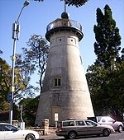Збірник "Amazing Australia "
Amazing Australia
(Країнознавство)
Анотація
Даний посібник складається з текстових матеріалів про географічне положення, населення, культуру та політичний устрій Австралії, які містять у собі сучасну лексику та пізнавальну інформацію. Кожен текст супроводжується декількома запитаннями, які сприяють кращому засвоєнню інформації. Наприкінці розділу пропонуються невеликі тести, метою яких є закріплення й контроль лексичних навичок і навичок письмової мови та розробки уроків з використанням поданих матеріалів
Посібник призначений для вчителів англійської мови загальноосвітніх навчальних закладів.
Зміст
|
І. Вступ. Використання елементів країнознавство на уроках англійської мови ………………………………. |
6 |
|
ІІ. Amazing Australia Country profile ...…………………………………………... Geography …………………………………………………. Climate Regions …………………………………………… Australian capital territory …………………………………. History ……………………………………………………... Culture ……………………………………………………... Government ………………………………………………... Famous people ……………………………………………... Some interesting facts ……………………………………… Total test …………………………………………………… Keys ……………………………………………………….. |
8 9 10 12 13 14 15 16 17 19 22 |
|
ІІІ. Висновок …………………………………………………. |
23 |
|
IV. Використана література …………………………………. |
24 |
|
V. Додатки …………………………………………………… |
25 |
Вступ
Гарні знання мови – це не тільки знання лексичного матеріалу, але й культурної і мовної компетенції.
Мова та суспільство тісно пов’язані між собою. Мова – одна з головних в кожній країні. Вона відображає культуру і мову людей, які в ній живуть. Тому її вивчення не можна уявити без культурних складових мови, яка вивчається.
Освіта засобами іноземної мови передбачає знання про культуру, історію, реалії і традиції країни, мова якої вивчається, знайомство з досягненнями національних культур у розвитку загальнолюдської культури, усвідомлення ролі рідної мови та культури в дзеркалі культури іншого народу.
Звертання до проблеми вивчення мови і культури одночасно не випадково, так як це дозволяє вдало поєднувати елементи країнознавства з мовними явищами, що є не лише засобом комунікації, а й засобом ознайомлення з новою дійсністю. Такий підхід до навчання іноземної мови в закладах освіти в більшості забезпечує не лише більш ефективне розв’язання практичних, загальноосвітніх, розвиваючих та виховних завдань, а й містить в собі величезні можливості для підтримання мотивації навчання.
Країнознавство − базова для методики наука, предметом якої є сукупність відомостей про країну мови, яка вивчається. Країнознавство дає уявлення про соціально-економічний стан країни та народу, про звичаї, традиції, культурні цінності, притаманні даному народу. Будучи науковою дисципліною, країнознавство займається комплексним вивченням країн і регіонів. На заняттях з мови використання країнознавчої інформації носить прикладний характер. Вона включається в систему занять в процесі знайомства учнів зі змістом і формами мовного спілкування носіїв мови, що вивчається. Така інформація забезпечує не тільки пізнавальні, а й комунікативні потреби учнів, сприяючи формуванню комунікативної і соціокультурної компетенції.
Широке й постійне використання у навчальній роботі країнознавчих матеріалів, що мають освітній, виховний та розвиваючий потенціал, формує інтерес учнів до вивчення іноземної мови, з яким пов’язані значні резерви підвищення ефективності навчання іноземної мови. Тому виникає проблема забезпечення учнів країнознавчими знаннями та застосування цих знань у процесі навчання спілкування іноземною мовою.
Я вважаю, що використання країнознавчого матеріалу стимулює учнів до поглибленого вивчення іноземної мови, навчає таким прийомам мислення, як порівняння, узагальнення; удосконалює інтелектуальні здібності: пам’ять, уяву, критичне, логічне та креативне мислення.
Тому в даному посібнику всі запропоновані тексти є автентичними й пізнавальними, містять цікаву інформацію. Вправи до творів підібрано на основі методичної літератури і власного досвіду викладання у школі й мають на меті закріпити й перевірити:
- знання певної лексики (лексичні вправи);
- розуміння тексту;
- знання граматики.
З допомогою вправ до текстів школярі мають змогу поглибити знання і набути нових вмінь і навичок.
![]()
Country Profile
|
Flag |
|
|
Full Name |
Commonwealth of Australia |
|
Population |
21,110,000 in 2007 (53rd worldwide) |
|
Capital |
Canberra |
|
Largest City |
Sydney |
|
Area |
7,741,220 km2 (6th worldwide) |
|
Official language |
English |
|
Currency |
Australian dollar |
|
Internet domain |
.au |
|
Calling code |
+61 |
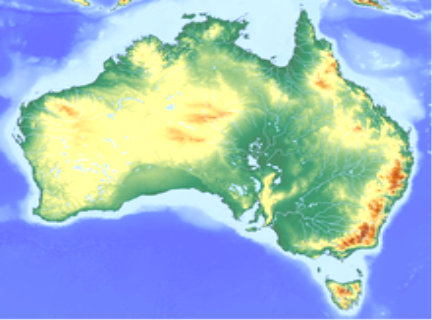 Topography of Аustralia
Topography of Аustralia
Geography
Located between the Indian and the Pacific oceans, Australia is a country that covers most of the Australia-Oceania continent. It borders on the Arafura Sea and Timor Sea on the north, and the Tasman Sea on the south-east.
Australia has a very dramatic landscape. Australia is famous for its "outback," the remote lands of the interior.
The desert outback covers most of the interior. It is too hot, dry and barren to support many people.
Eastern Australia has large areas of grasslands, used primarily for sheep and cattle ranches.
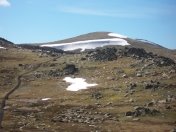 Australia also has some mountainous areas and plateaus scattered throughout the country. The Blue Mountains, on the south-eastern end of Australia, get their name from the blue haze caused by oil droplets given off from the eucalyptus trees. As an island, Australia also has many
Australia also has some mountainous areas and plateaus scattered throughout the country. The Blue Mountains, on the south-eastern end of Australia, get their name from the blue haze caused by oil droplets given off from the eucalyptus trees. As an island, Australia also has many
beautiful coastal beaches Mount Kosciuszko.
The highest point on the Australian mainland is Mount Kosciuszko, New South Wales, at 2228 metres above sea level. The lowest point is the dry bed of Lake Eyre, South Australia, which is 15 metres below sea level.
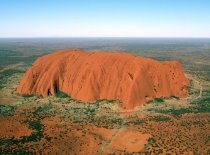 Mount Augustus, located in Western Australia, is the world's biggest monolith. But Uluru, also called Ayers Rock, is the most popular monolith and is an icon for Australia.
Mount Augustus, located in Western Australia, is the world's biggest monolith. But Uluru, also called Ayers Rock, is the most popular monolith and is an icon for Australia.
Over 70% of Australians now live in cities or towns. Most of this population lives in the eastern and southern coasts and around Perth in
Uluru the west. The country also hosts a great variety of marsupial animals such as the koala and the kangaroo.
Australia consists of six states, which are the New South Wales (NSW), Queensland (QLD), South Australia (SA), Tasmania (TAS), Victoria (VIC) and Western Australia (WA). There are also two major mainland territories, the Northern Territory (NT) and the Australian Capital Territory (ACT). Most of the population resides along the south-east coast, mainly in the cities of Sydney and Melbourne.
Off the northeast coast of Australia is the Great Barrier Reef. The Great Barrier Reef is over 1,200 miles of coral. It has developed over the last million years, and is now the largest living structure in the world.
The Great Barrier Reef is the world's largest coral reef. It extends for over 2,000 kilometres on the north-eastern coasts of the country.
It is home to many sharks and thousands of different types of tropical fish.
QUESTIONS
- Where is Australia situated?
- How many separate parts does Australia consist of?
- What are these parts?
- What waters is Australia washed by?
- What animals can be found in Australia?
- Where is the Great Barrier Reef?
- What is Uluru?
- Why is Australia famous for its "outback"?
- Which is the highest mountain of Australia?
Climate Regions
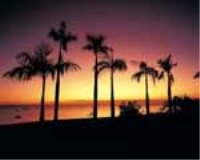 Much of Australia has a continental climate. The temperatures get hot during the day, then drop considerably at night. Australia is a huge country (but small continent). It doesn't have one temperature like
Much of Australia has a continental climate. The temperatures get hot during the day, then drop considerably at night. Australia is a huge country (but small continent). It doesn't have one temperature like
Singapore. The weather tends to vary more from north to south than it does west to east
TROPICS: The northern part of the country (northern Western Australia, the Northern Territory, and extreme northern Queensland) are all relatively close to Indonesia and share its tropical weather. There are really only two seasons here, the Wet (November to April) and the Dry (May to October). The Wet season has temperatures between 30-50° C (86-122° F). In the Dry, temperatures are a more reasonable 20° C (68° F). There is a build up period between the Wet and the Dry, as the season transitions from one to the other. Humidity is high. Winter temperatures are actually pleasant. It doesn't get colder than 14° C (57° F). The ideal time to visit the tropical regions, like Darwin, Kakadu, Karijini National Park, etc is September-October.
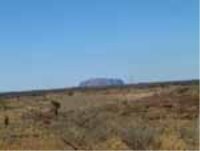 OUTBACK: The Outback, the sparsely populated area in the central part of the country is best thought of as a desert, with very hot days and very cool nights. Considering that the winters in Australia aren't anything close to a day in Antarctica, the best time to be in the Outback -- places like Cooper Pedy, Alice Springs, or areas more remote -- is winter, when temperatures are about 20° C (68° F), like a cool summer's day in other parts of the world. A real summer's day in one of these places can average the same as your body temperature -- 37° C (98.6° F) Thermal underwear and a heavily insulated sleeping bar are mandatory if you are camping in the Outback during the Australian winter.
OUTBACK: The Outback, the sparsely populated area in the central part of the country is best thought of as a desert, with very hot days and very cool nights. Considering that the winters in Australia aren't anything close to a day in Antarctica, the best time to be in the Outback -- places like Cooper Pedy, Alice Springs, or areas more remote -- is winter, when temperatures are about 20° C (68° F), like a cool summer's day in other parts of the world. A real summer's day in one of these places can average the same as your body temperature -- 37° C (98.6° F) Thermal underwear and a heavily insulated sleeping bar are mandatory if you are camping in the Outback during the Australian winter.
TEMPERATE REGIONS: This applies to most of the rest of
the areas of the country where the majority of tourists are likely to devote their time. We're talking about Melbourne, Adelaide, Sydney, and Perth, and the areas in between. Summer temperatures average 30° C (86° F) and winter temperatures 15° C (59° F). These are temperatures any normal person could easily live with. Tasmania in the summer can get quite cold, with nighttime temperatures below 10° C (50° F) and sometimes below freezing the national parks. Before I'd bothered to purchase a wider range temperature sleeping bag, I emerged a few evenings with icicles sprouting of my nostrils. Tasmania may be better thought of as having a climate more similar to New Zealand than the rest of mainland Australia.
QUESTIONS
- What climate does Australia enjoy?
- What are the characteristic of this climate?
- Characterize the climate of the northern part of Australia.
- Describe the climate of the Outback.
- What can you say about the climate in Melbourne, Adelaide, Sydney, and Perth, and the areas in between?
Australian Capital Territory
In 1908, the Federal Parliament designated the territory for the national capital and annexed further land at Jervis Bay on the New South Wales coast so the national capital could have a seaport.
Fertile farming lands, the Great Dividing Range and alpine peaks surround the Australian Capital Territory (ACT).
The territory has an abundance of nature with 53 per cent of the total area preserved as parks and reserves.
Our clean air comes from extensive forests and pure water comes from pristine catchments fed by pure rain and snowmelt.
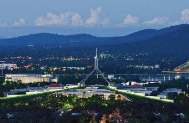 Canberra, the urban centre of the ACT, is a thriving modern city of around 367,000 people.
Canberra, the urban centre of the ACT, is a thriving modern city of around 367,000 people.
Just 45 minutes drive from the city is Tidbinbilla Nature Reserve offering walking trails, ranger-guided activities, Australian animals in their natural habitat, a chance to see conservation work with programs to restore threatened species including the brush tailed rock
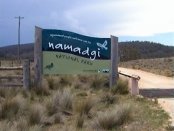 wallaby and corroboree frog, delightful wildflowers during spring and rich Indigenous and pioneer heritage.
wallaby and corroboree frog, delightful wildflowers during spring and rich Indigenous and pioneer heritage.
Explore the purity of Namadgi National Park, a 45 minute drive from the city. Situated at the northern end of the Australian Alps, this park is perfect for a picnic or bushwalk along the numerous marked trails, to experience native flora and fauna and enjoy spectacular wildflowers in spring.
There is over 20,000 years of human occupation in the mountains which means it has been a natural destination for visitors longer than the Great Pyramids! The Indigenous rock art and Aboriginal shelters are easily accessible.
Camping is possible in pleasant bush land settings with fishing, mountain biking and horse riding permitted in designated areas.
QUESTIONS
- When did Canberra begin life?
- How many people live in Canberra?
- Where is Namadgi National Park situated?
- What can you find there?
- Describe the camping.
History
Australia's original inhabitants, the Aborigines, have settled between 42,000 and 48,000 years ago. They arrived via land bridges and short sea-crossings from Southeast Asia at a time where sea levels were lower.
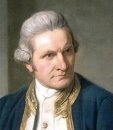 Many European explorers have sailed around Australia in the 16th and 17th century. The land was even called New Holland by the Dutch navigator Willem Janszoon. In 1770, James Cook sailed along the east coast of Australia and claimed it for Britain.
Many European explorers have sailed around Australia in the 16th and 17th century. The land was even called New Holland by the Dutch navigator Willem Janszoon. In 1770, James Cook sailed along the east coast of Australia and claimed it for Britain.
The first British settlement was established in 1788 at Port Jackson, naming it New South Wales, which today is the territory of Sydney. This date later became Australia's national day, Australia Day, the 26th of January.
James Cook
Other British colonies were created in the 19th century. They all formed a federation of colonies in 1901, and the Commonwealth of Australia was born, independent, but as a Dominion of the British Empire.
After the United Kingdom's defeat in Asia in World War II, and the threat of Japanese invasion, Australia turned to the United States as a new ally. The final constitutional ties with the UK ended in 1986, and now Australia is increasing focus as part of the Asia-Pacific region.
QUESTIONS
- When have Aborigines settled?
- What did they arrive?
- How was Australia called at first?
- Who claimed Australia for Britain?
- What day became Australia Day? Why?
- When did the last constitutional ties with UK end?
Culture
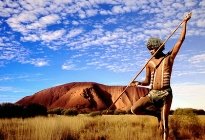 The primary basis of Australia's culture is Anglo-Celtic with some indigenous influence. But during the past 50 years, the Australian culture has been inspired by non-Speaking English countries, and by Asian culture. American popular culture has also influenced Australia in the music and movie domains.
The primary basis of Australia's culture is Anglo-Celtic with some indigenous influence. But during the past 50 years, the Australian culture has been inspired by non-Speaking English countries, and by Asian culture. American popular culture has also influenced Australia in the music and movie domains.
 90% of Australia's population is of European descent with English being the official language. The three largest ethnic groups are either born in New Zealand, Vietnam or China. The country has no state religion, although 64% of Australians call themselves Christian.
90% of Australia's population is of European descent with English being the official language. The three largest ethnic groups are either born in New Zealand, Vietnam or China. The country has no state religion, although 64% of Australians call themselves Christian.
The visual arts started with the indigenous people with landscape paintings in the caves that occurred around 50,000 years ago. After the arrival of the British, many Australian painters, such as Arthur Streeton, Arthur Boyd and Albert Namatjira, have also been demonstrating landscapes on their works of art.
 Australia has a long history of film production, from Crocodile Dundee to The Matrix. Many Australian actors are also known worldwide, including Cate Blanchett, Hugh Jackman and Nicole Kidman.
Australia has a long history of film production, from Crocodile Dundee to The Matrix. Many Australian actors are also known worldwide, including Cate Blanchett, Hugh Jackman and Nicole Kidman.
Sport plays an important element of Australian culture, with rugby being very popular. Australia is one of the few countries that has participated in every single summer Olympic Games, and has hosted the 1956 Games in Melbourne and the 2000 Games in Sydney.
QUESTIONS
- What is the basis of Australia’s culture?
- How has Australia’s culture chanced during the past 50 years?
- How many people in Australia are Christian?
- What Australia’s painters do you know?
- Describe history of film production in Australia.
- What can you say about sport in this country?
Government
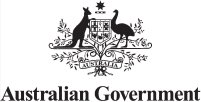 Two mainland territories and six states compose the federated Commonwealth of Australia. The territories are the Australian Capital Territory and the Northern Territory. The states are New South Wales, Victoria, Queensland, South Australia, Western Australia and Tasmania.
Two mainland territories and six states compose the federated Commonwealth of Australia. The territories are the Australian Capital Territory and the Northern Territory. The states are New South Wales, Victoria, Queensland, South Australia, Western Australia and Tasmania.
The Commonwealth of Australia is a parliamentary state (formerly a constitutional monarchy) based on a federal division of powers.
The bicameral Commonwealth Parliament consists of the Senate (the upper house) of 76 senators, and a House of Representatives (the lower house) of 150 members. Elections for both chambers are normally held every three years, simultaneously. The party with majority support in the House of Representatives forms the government and its leader becomes Prime Minister. Voting is compulsory.
Politics has generally been a contest between the Australian
Labor Party (ALP) and other non-labour parties. The ALP has been in power since the November 2007 election, with Kevin Rudd as Prime
Minister until his resignation in July 2010 and was replaced by Australia's first female Prime Minister, Julia Gillard.
The legal system is based on English common law. The administration of the law is largely in the hands of the states, each with a series of courts, culminating in a supreme court. The High Court of Australia, the federal Supreme Court, has general appellate jurisdiction over the state courts; its justices are appointed by the Governor-General.
QUESTIONS
- What political system is in Australia?
- How many branches are in Australia? What are they?
- How many members are in the Senate?
- How many members are in a House of Representatives?
- Who was the first female Prime Minister? When?
Famous People in Australia
 Born in the USA, Mel Gibson moved to Australia at a young age and is considered Australian. He is famous for his roles in films such as Braveheart, Mad Max, Lethal Weapon and The Patriot. Here is fighting scene from The Patriot.
Born in the USA, Mel Gibson moved to Australia at a young age and is considered Australian. He is famous for his roles in films such as Braveheart, Mad Max, Lethal Weapon and The Patriot. Here is fighting scene from The Patriot.
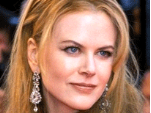 Nicole Kidman is one of Australia’s most famous actresses. She is also famous for her wedding with Tom Cruise and her more recent wedding with her current husband, the country and western singer, Keith Urban. Some of her more famous films include Moulin Rouge, Eyes Wide Shut, and more recently, Australia.
Nicole Kidman is one of Australia’s most famous actresses. She is also famous for her wedding with Tom Cruise and her more recent wedding with her current husband, the country and western singer, Keith Urban. Some of her more famous films include Moulin Rouge, Eyes Wide Shut, and more recently, Australia.
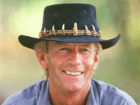 Paul Hogan is an Australian actor internationally famous for playing Mick Dundee in the iconic Australian film, Crocodile Dundee.
Paul Hogan is an Australian actor internationally famous for playing Mick Dundee in the iconic Australian film, Crocodile Dundee.
 Like Mel Gibson, Russell Crowe was not born in Australia. He was born in New Zealand and moved to Australia at a very young age. He is famous for films such as Proof, Romper Stomper, The Insider and Gladiator. He is the co-owner of the rugby league team South Sydney Rabbitohs and is also notorious for having an occasionally aggressive personality.
Like Mel Gibson, Russell Crowe was not born in Australia. He was born in New Zealand and moved to Australia at a very young age. He is famous for films such as Proof, Romper Stomper, The Insider and Gladiator. He is the co-owner of the rugby league team South Sydney Rabbitohs and is also notorious for having an occasionally aggressive personality.
 Even though she began her career in the famous Australian soap opera, Neighbours, Kylie has risen to international pop-stardom, with over two decades of pop hits on the music charts. Some of her famous hits include ‘I Should Be So Lucky’, ‘Spinning Around’, ‘Fever’ and ‘Can’t Get You Out of My Head’.
Even though she began her career in the famous Australian soap opera, Neighbours, Kylie has risen to international pop-stardom, with over two decades of pop hits on the music charts. Some of her famous hits include ‘I Should Be So Lucky’, ‘Spinning Around’, ‘Fever’ and ‘Can’t Get You Out of My Head’.
She is also famous for overcoming breast cancer at a relatively young age. The following is her video clip for ‘Can’t Get You Out of My Head.’
Some Interesting Facts
- Australia is the 6th biggest country worldwide, located on the smallest continent.
- The word kangaroo means "What did you say" in the aboriginal language, when the first European settlers asked about that animal.
- The name Australia is derived from the Latin word "Australis", which means the south. Legends of an "unknown land of the south" dated back to Roman times but they were not based on any actual knowledge of the continent.
- Australia is the driest country; it has the lowest precipitation of any of the world's inhabited continents (Antarctica gets less).
- The tropical north of Australia is home to the world's largest species of crocodile, the salt water crocodile. Males can occasionally grow to lengths of over 6 meters (20 feet). Each year one or two people are eaten by crocodiles in Australia
Total test
- Fill in the blanks with the correct words from the list:
Monolith, sharks, coral reef, mainland, north-eastern, south-eastern, Australia-Oceania
- Australia is a country that covers most of the _______________ continent.
- The Blue Mountains, on the _______________ end of Australia, get their name from the blue haze caused by oil droplets given off from the eucalyptus trees.
- The highest point on the Australian _______________ is Mount Kosciuszko.
- But Uluru, also called Ayers Rock, is the most popular ___________ and is an icon for Australia.
- The Great Barrier Reef is the world's largest ____________. It extends for over 2,000 kilometres on the ____________ coasts of the country.
- It is home to many _________ and thousands of different types of tropical fish.
- Correct the mistakes using the sentences from the text.
- Much of Australia has a monsoon subtropical climate.
- It has one temperature like Singapore.
- The southern part of the country (northern Western Australia, the Northern Territory, and extreme northern Queensland) are all relatively close to Indonesia and share its tropical weather.
- The Outback, the sparsely populated area in the northern part of the country is best thought of as a desert, with very hot days and very cool nights.
- Tasmania in the summer can get quite hot.
- Sydney may be better thought of as having a climate more similar to New Zealand than the rest of mainland Australia.
- Match the words making word combinations. Make up all possible sentences with them.
- large areas a) forests
- the highest b) bar
- consists of c) activities
- sleeping d) point
- farming e) six states
- extensive f) lands
- ranger-guided g) of grasslands
-
 Who is this man? Tell some facts about him.
Who is this man? Tell some facts about him.
- Writing tasks.
- Imagine yourself to be a tour guide. Make a guided survey on historical past of Australia using the information got from the texts.
- You are on holiday. Write a postcard to an English-speaking friend telling him about political system and culture in Australia.
-
 Try to use as many facts as you can and make your own conclusion about this city.
Try to use as many facts as you can and make your own conclusion about this city.
- Match photos of famous people with their names. After that tell some facts about their lives.
|
|
|
|
|
|
|
|
|
|
|
|
|
5.
|
|
KEYS
- 1. Australia-Oceania. 2. South-eastern. 3. Mainland. 4. Monolith. 5. Coral reef, south-eastern. 6. Sharks.
- 1. Monsoon subtropical – continental. 2. Has – doesn’t have. 3. The southern part – The northern part. 4. The northern part – the central part. 5. Hot – cold. 6. Sydney – Tasmania.
- 1. g; 2. d; 3. e; 4. b; 5. f; 6. a; 7. c.
- 1. c; 2. d; 3. е; 4. а; 5. b.
Висновок
Оволодіння соціокультурною компетенцією, як відомо, передбачає засвоєння необхідного мінімуму соціокультурних знань, а також системи навичок та вмінь узгоджувати свою поведінку у відповідності до цих знань та вмінь.
Тексти для читання необов'язково повинні повторювати тематику усного мовлення, але вони повинні будуватися на знайомому мовному матеріалі, незнайомих слів повинно бути не більше 2%. Вони мають бути новими для учнів, відповідати їх інтересам і віку, мати виховну цінність.
При підборі текстів акцент робиться на країнознавчий підхід як на єдиний спосіб зберегти в матеріалі для читання усі компоненти автентичності.
Виконавши цю роботу, я дійшла висновку, що навчання природній, живій мові можливе лише за умови використання матеріалів, узятих з життя носіїв мови, або спираючись на переклади оригіналів творів відомих письменників та поетів чи усної народної творчості, складених з урахуванням особливостей культури і менталітету відповідно до прийнятих мовних норм. Автентичний текст є природним мовним твором, створеним з методичною метою. Я вважаю, що розробка подібних навчальних текстів дозволить більш ефективно здійснити навчання усім видам мовленнєвої діяльності, імітувати занурення в природне мовне середовище на уроці іноземної мови.
Використана література
- Настольная книга преподавателя иностранного языка: Справочное пособие / Е.А. Маслыко, П.К. Бабинская, А.С. Будько, С.И. Петрова.: Высшая школа., 1999. – 522 с.
- Методика обучения иностранным языкам: Базовый курс лекций: Пособие для студентов пед. Вузов и учителей / Е.Н. Соловова. – М.: Просвещение, 2003. – 239 с.
- Методика обучения иностранным языкам в средней школе / Под ред. Г.В. Рогова, Ф.М. Рабинович, Т.Е. Сахарова. – М.: Просвещение, 1991. – 287 с.
- Методика обучения иностранным языкам в средней школе / В.П. Кузовлев.: Просвещение., 1996. – 143 с.
- Методика обучения иностранным языкам в средней школе / А. П. Миньяр-Белоручева.: Проспект., 2001. – 96 с.
- Современная методика обучения иностранным языкам / Н.Д. Галльская – М.: АРКТИ, 2003. – 129 с.
- Савина С.Н. Внеклассная работа по иностранному языку в средней школе.- М.: Просвещение, 1991.- С. 42-54.
- Уэст М. Методика обучения чтению / Иностранные языки в школе.-2003-№3.-С.46-47.
Додаток 1
AUSTRALIA: GEOGRAPHICAL POSITION AND CLIMATЕ
Цілі: навчальні: вдосконалювати навички усного мовлення, аудіювання, читання та письма; удосконалювати навички й уміння правильно відповідати на запитання;
розвивальні: розвивати вміння правильно знаходити й відбирати необхідну інформацію; розвивати пам'ять, мислення, навички монологічного та діалогічного мовлення; сприймання іноземної мови на слух;
освітні: активізувати вживання ЛО в мові учнів із визначними місцями Австралії, розширювати знання учнів про країну; виховні: вчити дотримуватися культури мовлення; виховувати інтерес і дбайливе ставлення до пам’яток культури.
Обладнання: підручник, карти штатів Австралії, текст «The Climate of Australia»
Plan of the lesson
- Introduction
Greetings. Teacher explains the theme and the aims of the lesson.
- Warming-up. Game “Word Chain”
- Vocabulary practice
- Listening to the text “Australia” with doing tasks.
- Oral practice. Short stories about the biggest cities in Australia.
- Reading. Read the text “Climate in Australia” and answer the questions.
- Writing. Complete the “Fact File”
- Summary
Procedure
- GREETING. INTRODUCTION
T. Good morning! Glad to see you. How are you? I’m glad you are in good mood. Please don’t feel anxious at the lesson today. Today we have an unusual lesson. The theme of our lesson is “Australia”. The aims are to get more information about this country and its beautiful cities and develop listening, reading, speaking and writing skills. At the end of the lesson you:
- Will revise the geographical names;
- Will be able to speak about Australia;
- Will be able to make a Fact File about the country.
II. WARMING-UP ACTIVITY
Game “Word Chain”
T. You have the word “Australia”. Your task is to name the words you associate with the topic. Every next word should begin with the last letter of the previous one.
For example: Australia → altitude → ethnic → continental → etc.
III. MIN PART OF LESSON
►►Vocabulary practice
T. Before we start talking about Australia let us revise some words and word combinations and geographical names.
- to be washed by
- to be separated
- the Pacific ocean
- the Indian ocean
- to border on
- the Arafura Sea
- the Timor Sea
- the Tasman Sea
- Uluru
- the Great Barrier Reef
- Mount Kosciuszko
►► Listening
T. I prepared a text for you to listen to. After listening to it you are to answer the questions and say whether the statements are true or false.
Australia. Geographical position
Located between the Indian and the Pacific oceans, Australia is a country that covers most of the Australia-Oceania continent. It borders on the Arafura Sea and Timor Sea on the north, and the Tasman Sea on the south-east.
Eastern Australia has large areas of grasslands, used primarily for sheep and cattle ranches.
Australia also has some mountainous areas and plateaus scattered throughout the country. The Blue Mountains, on the south-eastern end of Australia, get their name from the blue haze caused by oil droplets given off from the eucalyptus trees. As an island, Australia also has many
beautiful coastal beaches.
The highest point on the Australian mainland is Mount Kosciuszko, New South Wales, at 2228 metres above sea level. The lowest point is the dry bed of Lake Eyre, South Australia, which is 15 metres below sea level.
Mount Augustus, located in Western Australia, is the world's biggest monolith. But Uluru, also called Ayers Rock, is the most popular monolith and is an icon for Australia.
The country also hosts a great variety of marsupial animals such as the koala and the kangaroo.
Australia consists of six states, which are the New South Wales (NSW), Queensland (QLD), South Australia (SA), Tasmania (TAS), Victoria (VIC) and Western Australia (WA). There are also two major mainland territories, the Northern Territory (NT) and the Australian Capital Territory (ACT). Most of the population resides along the south-east coast, mainly in the cities of Sydney and Melbourne.
Off the northeast coast of Australia is the Great Barrier Reef. The Great Barrier Reef is over 1,200 miles of coral. It has developed over the last million years, and is now the largest living structure in the world.
After-listening activity
1) QUESTIONS
- Where is Australia situated?
- How many separate parts does Australia consist of?
- What are these parts?
- What waters is Australia washed by?
- What animals can be found in Australia?
- Where is the Great Barrier Reef?
- What is Uluru?
- Which is the highest mountain of Australia?
- TRUE OR FALSE
- Australia consists of four states.
- It washes by the Atlantic Ocean and Indian Ocean.
- Australia borders on the Arafura Sea and Timor Sea on the north.
- The Blue Mountains are situated on the south-western end of Australia.
- The Great Barrier Reef is over 1,200 miles of coral.
Keys: 1. F, 2. F, 3. T, 4. F, 5. T.
►► Oral Practice
T. Last time I asked you to prepare some interesting information about the biggest cities of Australia. Who wants to speak?
Canberra – is the capital city of Australia. With a population of over 312,000, it is Australia's largest inland city and the eighth largest Australian city overall. The city is located at the northern end of the Australian Capital Territory (ACT).
The highest point is Mount Majura at 888 metres (2,913 ft). Other large hills include Mt Taylor, Mt Ainslie, Mt Mugga Mugga and Black Mountain. The surrounding bush land and the original bush land that Canberra was built in is a mixture of eucalyptus savanna, open grassland, scrubland, swamp and dry eucalyptus forests.
Canberra has a marine west coastal climate with four distinct seasons. Canberra experiences hot, quite dry summers, and cold winters with heavy fog and frequent frosts, with a rare spot of snow in the CBD but the surrounding areas get annual snowfall through winter and often the snow capped mountains can be seen from the CBD.
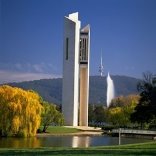
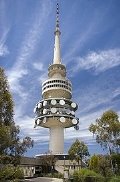
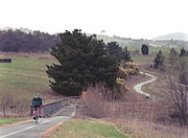
Melbourne – is the capital of state Victoria (population in state - 4645000), the second largest city in Australia.
You’ll enjoy traveling around Melbourne on the City Circle Tram. It runs every 10 minutes from 10. a.m. till 6 p.m. While you are sitting on the tram, the conductor will point out the most interesting sights in Melbourne.
Melbourne - is a very multicultural city. Over a quarter of the population was born overseas. It is home to many cultural groups, speaking 170 languages. It is one of the largest Greek and Italian populations in the world. Population of about 1,100,000.
Melbourne enjoys four distinct seasons. Winter with cool night; spring and autumn are delightful. Warm summer. Geologically, it is built on the confluence of Quaternary lava flows.
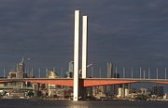
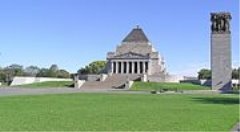
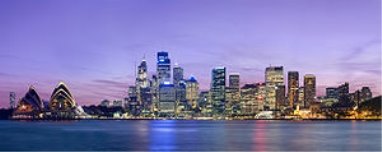
Sydney is the capital of New South Wales (population in state – 6372000). Australia’s oldest, largest and industrial city. Nearly a quarter of all Australians live here. Population of about 4,340,000 and growing.
 The City of Sydney has a soothing and pleasant climate with warm summers and cool winters. The city does not generally experience extremes of temperature differences but it can only occur under the influence of El Nino current and sudden hailstorms. Bushfires are a major problem in the outskirts of the city, especially during the summer season. The city is also considerably affected by the oceanic influences.
The City of Sydney has a soothing and pleasant climate with warm summers and cool winters. The city does not generally experience extremes of temperature differences but it can only occur under the influence of El Nino current and sudden hailstorms. Bushfires are a major problem in the outskirts of the city, especially during the summer season. The city is also considerably affected by the oceanic influences.
The City of Sydney is bordered by the Pacific Ocean in the east, by Blue Mountains in the west, Hawkesbury River in the north and Woronora plateau in the south. The City of Sydney is known for its wonderful beaches and coastal areas. There are more than seventy harbor areas in the Sydney urban area and Sydney Harbor is the largest natural harbor in the world.
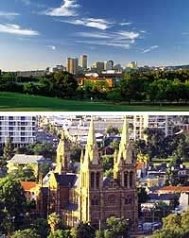 Adelaide- the capital of South Australia (population in state 1467000), was planned in 1836, by surveyor Colonel William Light. The city centre has a grid of wide streets and various squares all within 1 square mile. This centre is surrounded by a green belt of 930 hectares of parkland.. The main street, King William Street, runs from north to south through Victoria Square at the heart of the city. The climate is Mediterranean - with hot, dry summers and cool, mild winters. The average winter temperature is around 15C; average for summer is 29C. The Torrens River runs through the centre, separating Adelaide and North Adelaide. The city is surrounded by diverse landscapes, including the Mount Lofty Ranges (Adelaide Hills) and coastal beaches. Population of about 1,100,000.
Adelaide- the capital of South Australia (population in state 1467000), was planned in 1836, by surveyor Colonel William Light. The city centre has a grid of wide streets and various squares all within 1 square mile. This centre is surrounded by a green belt of 930 hectares of parkland.. The main street, King William Street, runs from north to south through Victoria Square at the heart of the city. The climate is Mediterranean - with hot, dry summers and cool, mild winters. The average winter temperature is around 15C; average for summer is 29C. The Torrens River runs through the centre, separating Adelaide and North Adelaide. The city is surrounded by diverse landscapes, including the Mount Lofty Ranges (Adelaide Hills) and coastal beaches. Population of about 1,100,000.
Brisbane - is the state capital of Queensland (population in state- 3655000) and its most populous city. It is also the third most populous city in Australia, behind southern rivals Sydney and Melbourne. The city is situated on the Brisbane River on a low-lying floodplain between Moreton Bay and the Great Dividing Range in Queensland. The city of Brisbane is hilly. Brisbane has a humid subtropical climate with hot, humid summers and dry, mild winters. Tropical climate makes it a year-round vacation place. Population of about 1,400,000.
Darwin, named after the famous naturalist, Charles Darwin, is Australia's most northernmost state capital-( North Territory-population 211000). Its tropical climate and proximity to Australia's northern neighbours has attracted many Asian immigrants, which in turn has helped turn this once rough-and-ready frontier town into a multi-cultural city beside the sea. Population of about 70,000. Darwin is dominated by two distinct seasons. Darwin is the ‘gateway' to the world-famous Kakadu National Park, the gorgeous Litchfield National Park, dramatic Katherine Gorge, and the red crags of the Kimberley region.
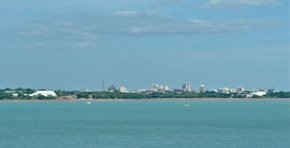
Hobart is the state capital and most populous city of the Australian island state of Tasmania (population of state of Tasmania is 457000). Founded in 1803 as a penal colony, Hobart is Australia's second oldest capital city after Sydney. The city is the financial and administrative heart of Tasmania, and also serves as the home port for both Australian and French Antarctic operations.Population of about 200,000. Hobart has a mild temperate oceanic climate with four distinct seasons. Unseasonal mountain snow covering has been known to occur during all seasons. Though snow is unusual in general at sea level in Australia, Hobart has most probably had the most sea level snowfalls out of any State Capital, though Sydney, Melbourne and Adelaide have also recorded snow.
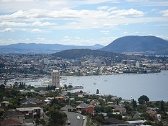
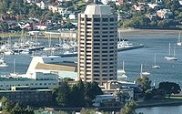
Perth - is the capital of state of Western Australia (population in state is 1851000). Population of about 200,000. Perth ranks fourth amongst the nation's cities, with a growth rate consistently above the national average. Perth is one of the most isolated metropolitan areas on Earth. The nearest city to Perth with a population over 1 million is Adelaide in South Australia, which is 2,104 kilometers (1,307 mi) away.
The city centre and most of the suburbs are located on the sandy and relatively flat Swan Coastal Plain, which lies between the Darling Scarp and the Indian Ocean. Summers are generally hot and dry, lasting from late December to late March, with February generally being the hottest month of the year, making Perth a classic example of a Mediterranean climate.
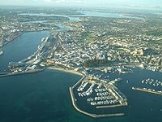
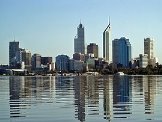
►► Reading
T. Read the text
CLIMATE OF AUSTRALIA
Much of Australia has a continental climate. The temperatures get hot during the day, then drop considerably at night. Australia is a huge country (but small continent). It doesn't have one temperature like
Singapore. The weather tends to vary more from north to south than it does west to east
TROPICS: The northern part of the country (northern Western Australia, the Northern Territory, and extreme northern Queensland) are all relatively close to Indonesia and share its tropical weather. There are really only two seasons here, the Wet (November to April) and the Dry (May to October). The Wet season has temperatures between 30-50° C (86-122° F). In the Dry, temperatures are a more reasonable 20° C (68° F). There is a build up period between the Wet and the Dry, as the season transitions from one to the other. Humidity is high. Winter temperatures are actually pleasant. It doesn't get colder than 14° C (57° F). The ideal time to visit the tropical regions, like Darwin, Kakadu, Karijini National Park, etc is September-October.
OUTBACK: The Outback, the sparsely populated area in the central part of the country is best thought of as a desert, with very hot days and very cool nights. Considering that the winters in Australia aren't anything close to a day in Antarctica, the best time to be in the Outback -- places like Cooper Pedy, Alice Springs, or areas more remote -- is winter, when temperatures are about 20° C (68° F), like a cool summer's day in other parts of the world. A real summer's day in one of these places can average the same as your body temperature -- 37° C (98.6° F)
TEMPERATE REGIONS: This applies to most of the rest of
the areas of the country where the majority of tourists are likely to devote their time. We're talking about Melbourne, Adelaide, Sydney, and Perth, and the areas in between. Summer temperatures average 30° C (86° F) and winter temperatures 15° C (59° F). These are temperatures any normal person could easily live with. Tasmania in the summer can get quite cold, with nighttime temperatures below 10° C (50° F) and sometimes below freezing the national parks Tasmania may be better thought of as having a climate more similar to New Zealand than the rest of mainland Australia.
T. Tell me please
- What climate does Australia enjoy?
- What are the characteristic of this climate?
Very nice. Now I have another assignment for you. Now on the board you’ll see some sentences with mistakes in it. You have to find and correct them.
- Much of Australia has a monsoon subtropical climate.
- The Outback, the sparsely populated area in the northern part of the country is best thought of as a desert, with very hot days and very cool nights.
- Tasmania in the summer can get quite hot.
- Sydney may be better thought of as having a climate more similar to New Zealand than the rest of mainland Australia.
Keys: 1. Monsoon subtropical – continental. 2. The northern part – the central part. 3. Hot – cold. 4. Sydney – Tasmania.
►► Writing
During the lesson we’ve talk about Australia. Now we will sum up all our knowledge in the form of “Fact File”. So open your copybooks take your pens and write down.
►► Fact File
Full name: ___________________________________________________
Capital: _____________________________________________________
Number of states: _____________________________________________
Population: __________________________________________________
Are: ________________________________________________________
Official language: _____________________________________________
The longest river: _____________________________________________
The highest mountain: __________________________________________
Climate: _____________________________________________________
IV. SUMMARY
T. let’s sum up the results of our lesson. Did you like it? Have you found new information?
►► Homework
T. Оur lesson comes to the end and your home assignment will be to talk about Australia using the Fact File.
Додаток 2
AUSTRALIA. “WHAT DO YOU KNOW ABOUT THIS COUNTRY?”
Цілі: практична: удосконалювати навички усного мовлення; практикувати учнів у виконанні тестів, які містять завдання з вивченої теми;
освітня: розширити й уточнити знання учнів про Австралію; розвивальна: розвивати пам’ять і логіку, розумові та мовленнєві здібності учнів;
виховна: виховувати повагу до культури країни, мова якої вивчається; прищеплювати любов до пізнання нового.
Обладнання: зошит, дошка, картки з тестами, зображення відомих людей та місць Австралії.
Plan of lesson
- Introduction
Greetings. Teacher explains the theme and the aims of the lesson.
- Warming-up. Brainstorming
- Speaking. Translate and complete the dialogue
- “Braing Ring”
- Summary
Procedure
- GREETING. INTRODUCTION
T. Good morning boys and girls. I’m glad to see you again. Today we are going to have a very special lesson. It will be the lesson-competition. I’ll divide you into two teams, and we’ll have some interesting contests. During these tasks you practice your spelling and systematize your knowledge from the topic.
- WARMING-UP
Brainstorming
But before we start we should brainstorm our minds. Your task is the following: answer the questions about the Australia as quickly as you can. So, are you ready? Let’s begin!
THE COMMONWEALTH OF AUSTRALIA
- By whom was Australia discovered and when was it happened?
- (Australia was discovered by Captain Cook in 1770)
- What is the official name of Australia? (The Commonwealth of Australia)
- What territories are there in the Commonwealth of Australia? (The Continent of Australia, the island of Tasmania and a number of smaller islands).
- What areas does Australia have? (About 8 million square kilometres)
- What is the capital of Australia? (Canberra)
- In what hemisphere is Australia situated? (The South hemisphere)
- What is the population of Australia? (20 million)
- What are the biggest cities in Australia? (Sydney, Melbourne, Adelaide, Perth, Brisbane)
- What mountains are there in Australia? (The Australian Alps, the Blue Mountains)
- What animals live in Australia? (They are the kangaroo, the dingo, the emu, the platypus, the koala, the echidna, the ostrich).
- What does Australia consist of? (Six states and two territories).
- Who is formally the head of the state? (The Queen of England – Elizabeth II).
- MAIN PART OF LESSON
►► Speaking
Pair work
T. Translate the following dialogue.
- Я знаю, що ти нещодавно повернувся з Австралії. Що ти можеш розповісти мені про цю країну?
- Австралія – це найменший континент між Індійським та Тихим океаном.
- А яке місто є столицею Австралії?
- Столиця Австралії – Канберра. А Сідней – найбільше місто в Австралії. Це найбільший порт та культурний центр країни.
- А чим іще відома Австралія?
- В Австралії є декілька кліматичних поясів, серед яких тропічний та субтропічний. Вона має багатий світ дикої природи. Також Австралія відома місцями, які ще не заселили люди («outback») та Великим бар’єрним рифом, який утворився протягом 1 млн років та є найбільшим у світі.
- Що тебе найбільше вразило в Австралії під час подорожі?
- Найбільше мене вразило місто Сідней,яке відоме своїми чудовими пляжами та оперним театром, який розташований на узбережжі.
- Дякую за розповідь. Вибач, але мені вже час іти до школи. Бувай.
Dialogue building. Acting out
♦ read the dialogue in pairs. Dramatize it.
►► Braing Ring
♦♦ Round 1
T. So, we start our first round.
I’ll ask you questions and you will answer them one by one. There are three variants of answers on the cards and your task is to choose the correct one.
1. Australia is situated in the
a) Northern Hemisphere
b) Southern Hemisphere
c) Western Hemisphere
2. What is the capital of Australia?
a) Sydney
b) Darwin
c) Canberra
3. The official language is
a) Australian
b) English
c) Spanish
4. The formal head of the state is
a) The prime - minister
b) The Queen of the UK
c) The president of the USA
5. Which is/ are popular Australian animal(s)?
a) Koala
b) Kangaroo
c) Emu
6. What animals can you see on the Australian coat of arms?
a) Kangaroo and Dingo
b) Koala and Parrot
c) Kangaroo and Emu
7. Which city is Australia's oldest and largest?
a) Sydney
b) Melbourne
c) Canberra
8. Who are the Australian natives?
a) Aborigines
b) Indians
c) Eskimos
9. Australia is
a) Country
b) Island
c) Continent
10. The number of the Australian states is
a) 50
b) 6
c) 10
♦♦ Round 2. Sights
T. On the blackboard you will see pictures of some sights of Australia and on the “Card 2” you can see their names. Your task is to match the pictures and their names. You will get 1 point for each correct matching. The team which will do the task first, will get 3 more points.
For this task you have one minute
- The Building of the Australian Academy of Sciences,
- The Rock “Three Sisters”,
- “Regent” – the Biggest Drama Theatre of the Continent,
- Sydney Opera House,
- The National Art Gallery,
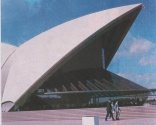
 a) b)
a) b)
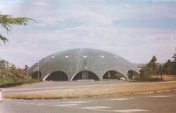
 c) d)
c) d)
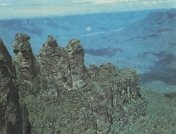 e)
e)
Keys: 1 – c; 2 – e; 3 – a; 4 – b; 5 – d.
♦♦ Round 3. Famous People
T. You will listen to some pieces of information about famous people of Australia. The student who recognizes this person up your hand, please. If team gives incorrect answer, you will not be able to give another one.
- He was born in the USA, moved to Australia at a young age and is considered Australian. He is famous for his roles in films such as Braveheart, Mad Max, Lethal Weapon and The Patriot. Here is fighting scene from The Patriot.
- Even though she began her career in the famous Australian soap opera, Neighbours, she has risen to international pop-stardom, with over two decades of pop hits on the music charts. Some of her famous hits include ‘I Should Be So Lucky’, ‘Spinning Around’, ‘Fever’ and ‘Can’t Get You Out of My Head’.
- She is also famous for overcoming breast cancer at a relatively young age. The following is her video clip for ‘Can’t Get You Out of My Head.’
- He was not born in Australia. He was born in New Zealand and moved to Australia at a very young age. He is famous for films such as Proof, Romper Stomper, The Insider and Gladiator. He is the co-owner of the rugby league team South Sydney Rabbitohs and is also notorious for having an occasionally aggressive personality.
- She is one of Australia’s most famous actresses. She is also famous for her wedding with Tom Cruise and her more recent wedding with her current husband, the country and western singer, Keith Urban. Some of her more famous films include Moulin Rouge, Eyes Wide Shut, and more recently, Australia.
- He is an Australian actor internationally famous for playing Mick Dundee in the iconic Australian film, Crocodile Dundee.
Keys: 1. Mel Gibson. 2. Kylie. 3. Russell Crowe. 4. Nicole Kidman. 5. Paul Hogan
Look at the photos and find them.


1. 2.


3. 4.

5.
Keys: 1. Kylie. 2. Russell Crowe. 3. Paul Hogan. 4. Mel Gibson. 5. Nicole Kidman.
♦♦ Round 4. Blitz quiz about Australia
T. So, there are some questions for you. They can help us to check your knowledge about Australia. The team which will give the correct answer to the question will get 1 point.
1. Jonathan Cooper likes his job. (Yes, he does)
2. Is the Art Gallery situated in Sydney? (Yes, it is)
3. Is Australian English different
from American and British English? (Yes, it is).
4. What are the most known Australia’s animals?
5. When is Australian national day? (26 January, 1877)
6. Is there one-teacher school in Australia? (Yes, there is)
7. The 1st of September is a special day,
isn’t it? (Yes, it is)
- SUMMARY
T. Thank all of you! Let’s count the points our competitors have got and name the winner.
Today we have talked a lot about Australia and its places of interest. You were active and got good marks. I hope you enjoyed the lesson and it will help you in the future and you will visit Australians cities. Maybe, our dreams will come true one day.
1

про публікацію авторської розробки
Додати розробку





